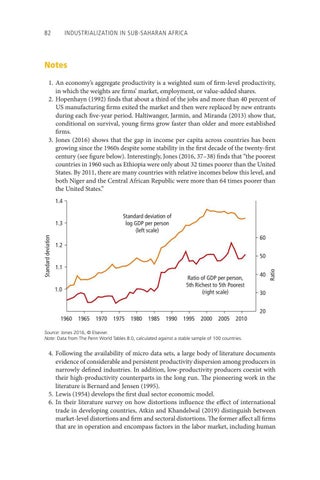82 Industrialization in Sub-Saharan Africa
Notes 1. An economy’s aggregate productivity is a weighted sum of firm-level productivity, in which the weights are firms’ market, employment, or value-added shares. 2. Hopenhayn (1992) finds that about a third of the jobs and more than 40 percent of US manufacturing firms exited the market and then were replaced by new entrants during each five-year period. Haltiwanger, Jarmin, and Miranda (2013) show that, conditional on survival, young firms grow faster than older and more established firms. 3. Jones (2016) shows that the gap in income per capita across countries has been growing since the 1960s despite some stability in the first decade of the twenty-first century (see figure below). Interestingly, Jones (2016, 37–38) finds that “the poorest countries in 1960 such as Ethiopia were only about 32 times poorer than the United States. By 2011, there are many countries with relative incomes below this level, and both Niger and the Central African Republic were more than 64 times poorer than the United States.” 1.4 Standard deviation of log GDP per person (left scale) 60 1.2 50 1.1 Ratio of GDP per person, 5th Richest to 5th Poorest (right scale)
1.0
40
Ratio
Standard deviation
1.3
30 20
1960
1965
1970
1975
1980
1985
1990
1995
2000
2005
2010
Source: Jones 2016, © Elsevier. Note: Data from The Penn World Tables 8.0, calculated against a stable sample of 100 countries.
4. Following the availability of micro data sets, a large body of literature documents evidence of considerable and persistent productivity dispersion among producers in narrowly defined industries. In addition, low-productivity producers coexist with their high-productivity counterparts in the long run. The pioneering work in the literature is Bernard and Jensen (1995). 5. Lewis (1954) develops the first dual sector economic model. 6. In their literature survey on how distortions influence the effect of international trade in developing countries, Atkin and Khandelwal (2019) distinguish between market-level distortions and firm and sectoral distortions. The former affect all firms that are in operation and encompass factors in the labor market, including human

